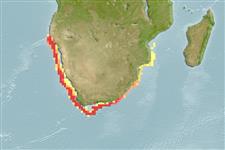>
Gadiformes (Cods) >
Merlucciidae (Merluccid hakes)
Etymology: Merluccius: Latin, mar, maris = the sea + Latin, lucius = pike (Ref. 45335).
Environment: milieu / climate zone / depth range / distribution range
Écologie
marin bathydémersal; non migrateur; profondeur 200 - 1000 m (Ref. 6605), usually 400 - ? m (Ref. 58452). Deep-water; 17°S - 38°S, 10°E - 48°E (Ref. 58452)
Southeast Atlantic: Cape Frio, Namibia south to the Agulhas Bank and east to East London in South Africa. Western Indian Ocean: Madagascar Ridge (33°S,44°E).
Length at first maturity / Taille / Poids / Âge
Maturity: Lm 47.8 range ? - ? cm
Max length : 115 cm TL mâle / non sexé; (Ref. 27121); common length : 60.0 cm SL mâle / non sexé; (Ref. 1371)
Épines dorsales (Total) : 1; Rayons mous dorsaux (Total) : 42 - 50; Épines anales: 0; Rayons mous anaux: 38 - 41. Body more slender than other hakes. Head large, about 25 to 30% of SL. Gill rakers short and thick with blunt tips. Pectoral fin tips reaching to level of anal fin origin. Color is steel gray on back, grading to silvery white ventrally.
Found near the bottom. Feeds on fishes, mysids, euphausiids and squids. Young feed mainly on euphausiids, but the diet becomes polyphagous with growth. Cannibalism has been observed in larger individuals (Ref. 9583).
Life cycle and mating behavior
Maturities | Reproduction | Spawnings | Egg(s) | Fecundities | Larves
Cohen, D.M., T. Inada, T. Iwamoto and N. Scialabba, 1990. FAO species catalogue. Vol. 10. Gadiform fishes of the world (Order Gadiformes). An annotated and illustrated catalogue of cods, hakes, grenadiers and other gadiform fishes known to date. FAO Fish. Synop. 125(10). Rome: FAO. 442 p. (Ref. 1371)
Statut dans la liste rouge de l'IUCN (Ref. 130435)
Menace pour l'homme
Harmless
Utilisations par l'homme
Pêcheries: hautement commercial
Outils
Articles particuliers
Télécharger en XML
Sources Internet
Estimates based on models
Preferred temperature (Ref.
123201): 6.2 - 12, mean 7.5 °C (based on 17 cells).
Phylogenetic diversity index (Ref.
82804): PD
50 = 0.5000 [Uniqueness, from 0.5 = low to 2.0 = high].
Bayesian length-weight: a=0.00525 (0.00348 - 0.00791), b=3.09 (2.96 - 3.22), in cm total length, based on LWR estimates for this species & Genus-body shape (Ref.
93245).
Niveau trophique (Ref.
69278): 4.9 ±0.2 se; based on diet studies.
Résilience (Ref.
120179): Faible, temps minimum de doublement de population : 4,5 à 14 années (K=0.09-0.12).
Fishing Vulnerability (Ref.
59153): High to very high vulnerability (65 of 100).
Climate Vulnerability (Ref.
125649): High vulnerability (55 of 100).
Nutrients (Ref.
124155): Calcium = 7.36 [3.59, 25.05] mg/100g; Iron = 0.274 [0.058, 0.735] mg/100g; Protein = 17.3 [16.1, 18.5] %; Omega3 = 0.146 [0.078, 0.273] g/100g; Selenium = 28 [13, 66] μg/100g; VitaminA = 11.7 [2.4, 55.4] μg/100g; Zinc = 0.186 [0.127, 0.288] mg/100g (wet weight);
